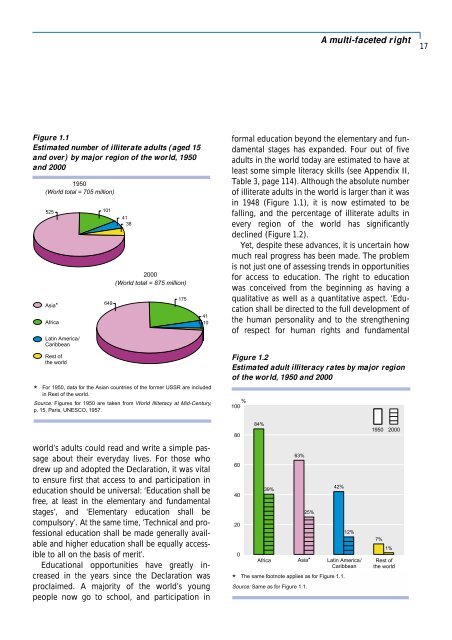The right to education - Asia Pacific Knowledge Base on Open and ...
The right to education - Asia Pacific Knowledge Base on Open and ...
The right to education - Asia Pacific Knowledge Base on Open and ...
Create successful ePaper yourself
Turn your PDF publications into a flip-book with our unique Google optimized e-Paper software.
A multi-faceted <str<strong>on</strong>g>right</str<strong>on</strong>g>17Figure 1.1Estimated number of illiterate adults (aged 15<strong>and</strong> over) by major regi<strong>on</strong> of the world, 1950<strong>and</strong> 2000*1950(World <str<strong>on</strong>g>to</str<strong>on</strong>g>tal = 705 milli<strong>on</strong>)525<str<strong>on</strong>g>Asia</str<strong>on</strong>g>*AfricaLatin America/CaribbeanRest ofthe world10164941382000(World <str<strong>on</strong>g>to</str<strong>on</strong>g>tal = 875 milli<strong>on</strong>)For 1950, data for the <str<strong>on</strong>g>Asia</str<strong>on</strong>g>n countries of the former USSR are includedin Rest of the world.Source: Figures for 1950 are taken from World Illiteracy at Mid-Century,p. 15, Paris, UNESCO, 1957.1754110formal <str<strong>on</strong>g>educati<strong>on</strong></str<strong>on</strong>g> bey<strong>on</strong>d the elementary <strong>and</strong> fundamentalstages has exp<strong>and</strong>ed. Four out of fiveadults in the world <str<strong>on</strong>g>to</str<strong>on</strong>g>day are estimated <str<strong>on</strong>g>to</str<strong>on</strong>g> have atleast some simple literacy skills (see Appendix II,Table 3, page 114). Although the absolute numberof illiterate adults in the world is larger than it wasin 1948 (Figure 1.1), it is now estimated <str<strong>on</strong>g>to</str<strong>on</strong>g> befalling, <strong>and</strong> the percentage of illiterate adults inevery regi<strong>on</strong> of the world has significantlydeclined (Figure 1.2).Yet, despite these advances, it is uncertain howmuch real progress has been made. <str<strong>on</strong>g>The</str<strong>on</strong>g> problemis not just <strong>on</strong>e of assessing trends in opportunitiesfor access <str<strong>on</strong>g>to</str<strong>on</strong>g> <str<strong>on</strong>g>educati<strong>on</strong></str<strong>on</strong>g>. <str<strong>on</strong>g>The</str<strong>on</strong>g> <str<strong>on</strong>g>right</str<strong>on</strong>g> <str<strong>on</strong>g>to</str<strong>on</strong>g> <str<strong>on</strong>g>educati<strong>on</strong></str<strong>on</strong>g>was c<strong>on</strong>ceived from the beginning as having aqualitative as well as a quantitative aspect. ‘Educati<strong>on</strong>shall be directed <str<strong>on</strong>g>to</str<strong>on</strong>g> the full development ofthe human pers<strong>on</strong>ality <strong>and</strong> <str<strong>on</strong>g>to</str<strong>on</strong>g> the strengtheningof respect for human <str<strong>on</strong>g>right</str<strong>on</strong>g>s <strong>and</strong> fundamentalFigure 1.2Estimated adult illiteracy rates by major regi<strong>on</strong>of the world, 1950 <strong>and</strong> 2000%100world’s adults could read <strong>and</strong> write a simple passageabout their everyday lives. For those whodrew up <strong>and</strong> adopted the Declarati<strong>on</strong>, it was vital<str<strong>on</strong>g>to</str<strong>on</strong>g> ensure first that access <str<strong>on</strong>g>to</str<strong>on</strong>g> <strong>and</strong> participati<strong>on</strong> in<str<strong>on</strong>g>educati<strong>on</strong></str<strong>on</strong>g> should be universal: ‘Educati<strong>on</strong> shall befree, at least in the elementary <strong>and</strong> fundamentalstages’, <strong>and</strong> ‘Elementary <str<strong>on</strong>g>educati<strong>on</strong></str<strong>on</strong>g> shall becompulsory’. At the same time, ‘Technical <strong>and</strong> professi<strong>on</strong>al<str<strong>on</strong>g>educati<strong>on</strong></str<strong>on</strong>g> shall be made generally available<strong>and</strong> higher <str<strong>on</strong>g>educati<strong>on</strong></str<strong>on</strong>g> shall be equally accessible<str<strong>on</strong>g>to</str<strong>on</strong>g> all <strong>on</strong> the basis of merit’.Educati<strong>on</strong>al opportunities have greatly increasedin the years since the Declarati<strong>on</strong> wasproclaimed. A majority of the world’s youngpeople now go <str<strong>on</strong>g>to</str<strong>on</strong>g> school, <strong>and</strong> participati<strong>on</strong> in*80604020084%39%63%25%42%12%Africa <str<strong>on</strong>g>Asia</str<strong>on</strong>g>* Latin America/Caribbean<str<strong>on</strong>g>The</str<strong>on</strong>g> same footnote applies as for Figure 1.1.Source: Same as for Figure 1.1.1950 20007%1%Rest ofthe world
















